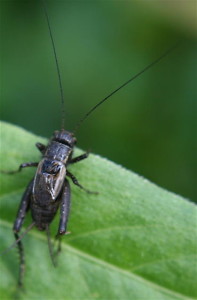How to Keep Crickets Out of Your House
By Chris Williams on July 24, 2014.
We’re already getting complaints about both camel crickets and field crickets getting into homes. Field crickets drive people crazy with their chirping (see “That Annoying Chirping!”). Camel crickets are scary because they jump so readily, but at least they don’t chirp (see “The Annual Return of the Camel Crickets”).
If you’ve ever tried to track down a cricket once it gets into your home, you know how difficult that can be. They’re difficult to kill with pesticide sprays once inside because they hide in inaccessible cracks and crevices. So, the best control for crickets is prevention—keeping them out in the first place.
Three Ways to Block Crickets
1. Outside perimeter treatment around your home – A pesticide treatment around the foundation of your home can block insects that are looking for a way inside. This is actually a good time to have a perimeter treatment because the major cricket invasion doesn’t occur until late summer or early fall. If you have a protective barrier in place before then you can stop crickets, as well as other fall-invading insects like stink bugs and Asian lady beetles from getting inside. Ask us about our Preventative Maintenance Program for the exterior of your home.
2. Pest exclusion measures – You can’t always tell how crickets are getting into your home, but sometimes it’s pretty obvious. For example, you know there’s a gap under the basement door, or there’s that opening where the television cable comes through the wall. A little caulking, screening, sealing of holes, installation of door sweeps, etc. can keep invading insects out. We call this pest exclusion and we offer it to our customers.
3. Foundation cleanup – The crickets that live around the foundation of your home are the ones that are going to find their way inside. You can reduce the chances of that happening by making the area around the outside of your house less habitable to crickets in the first place. These are the things that crickets like and that you should move or remove from the foundation: heavy mulch, piles of leaves, dense groundcovers or other thick vegetation, stacks of wood or stones. Fix any drainage problems around the foundation that are keeping the area damp. Finally, reduce outdoor lighting since field crickets will fly to lights and then enter through doors.
Photo: Cody Hough (Own work) [CC-BY-SA-3.0 or GFDL], via Wikimedia Commons
Sound: Thatcher (Own work) [CC-BY-SA-3.0], via Wikimedia Commons
